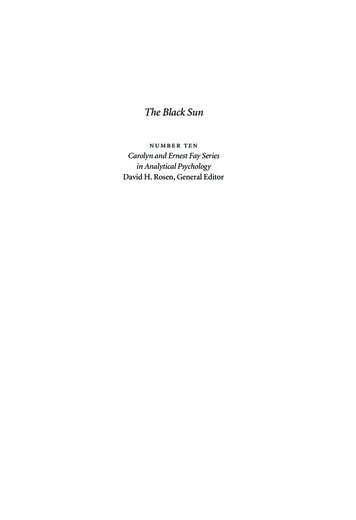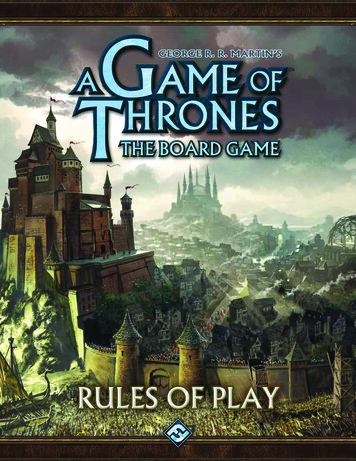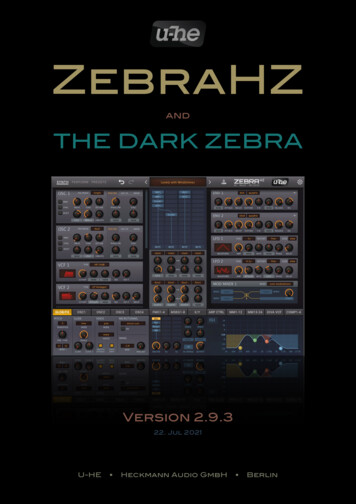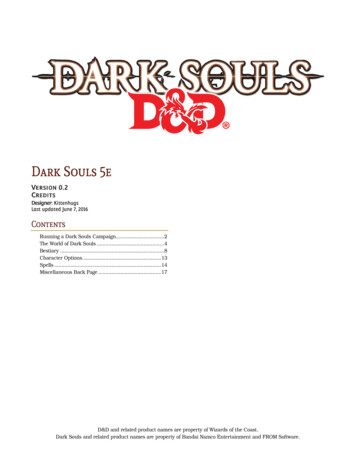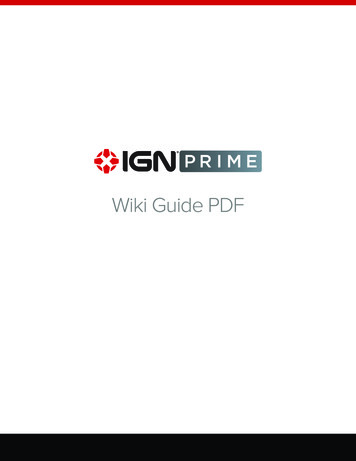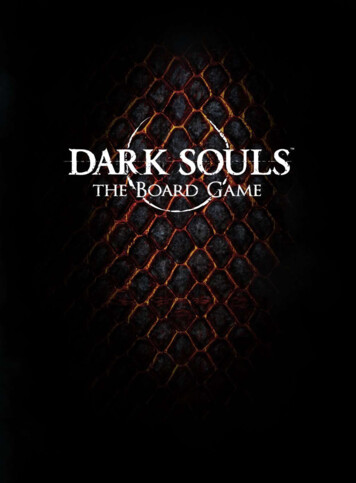
Transcription
1
ContentsIntroduction . . . . . . . . . . . . . . . 3Game Contents . . . . . . . . . . . . . 4Setup . . . . . . . . . . . . . . . . . . . . . 8Initial Setup . . . . . . . . . . . . . . . . . . . . 8Setup After the Mini Boss . . . . . . . . . 9Tiles and Nodes. . . . . . . . . . . . 10The Basics . . . . . . . . . . . . . . . . . . . . 10Node Movement . . . . . . . . . . . . . . . 10Range . . . . . . . . . . . . . . . . . . . . . . . . 10Node Model Limits . . . . . . . . . . . . . 10Character Activations . . . . . . . 22Overview . . . . . . . . . . . . . . . . . . . . . 22Character Movement . . . . . . . . . . . . 22Character Attacks . . . . . . . . . . . . . . 22Enemy Activations . . . . . . . . . 24Overview . . . . . . . . . . . . . . . . . . . . . 24Enemy Movement . . . . . . . . . . . . . . 24Enemy Attacks . . . . . . . . . . . . . . . . 25Boss Encounters . . . . . . . . . . . 26Character Boards . . . . . . . . . . . . . . . 11Estus Flask Tokens . . . . . . . . . . . . . 11Luck Tokens . . . . . . . . . . . . . . . . . . 11Boss Basics . . . . . . . . . . . . . . . . . . . . 26Boss Data Cards . . . . . . . . . . . . . . . 26Behaviour Cards . . . . . . . . . . . . . . . 27Boss Arcs . . . . . . . . . . . . . . . . . . . . . 27Starting a Boss Encounter . . . . . . . . 28Ending a Boss Encounter . . . . . . . . 28Equipment. . . . . . . . . . . . . . . . 12Boss Activations . . . . . . . . . . . 29The Bonfire Tile . . . . . . . . . . . 13Post-Game Ritual . . . . . . . . . . 31Characters . . . . . . . . . . . . . . . . 11Equipment Cards . . . . . . . . . . . . . . 12Upgrade Cards . . . . . . . . . . . . . . . . . 12Equipment Modifiers . . . . . . . . . . . 12Embers. . . . . . . . . . . . . . . . . . . . . . . 12Home Base . . . . . . . . . . . . . . . . . . . 13Blacksmith Andre . . . . . . . . . . . . . . 14The Firekeeper . . . . . . . . . . . . . . . . . 15Resting at the Bonfire . . . . . . . . . . . 15Overview . . . . . . . . . . . . . . . . . . . . . 29Boss Attacks . . . . . . . . . . . . . . . . . . 29Boss Movement . . . . . . . . . . . . . . . . 29Boss Activation Example . . . . . . . . . 30Exploration . . . . . . . . . . . . . . . 16Into the Dungeon . . . . . . . . . . . . . . 16The Fog Gate . . . . . . . . . . . . . . . . . . 16Encounter Setup . . . . . . . . . . . 17Encounter Cards . . . . . . . . . . . . . . . 17Terrain . . . . . . . . . . . . . . . . . . . . . . . 17Trap Tokens . . . . . . . . . . . . . . . . . . . 18Encounter Setup Example . . . . . . . . 18Encounters . . . . . . . . . . . . . . . 19The Basics . . . . . . . . . . . . . . . . . . . . 19Activating Models . . . . . . . . . . . . . . 19Ending an Encounter . . . . . . . . . . . 19Combat Basics . . . . . . . . . . . . . 20Target versus Hit . . . . . . . . . . . . . . . 20The Endurance Bar . . . . . . . . . . . . . 20Enemy Data Cards . . . . . . . . . . . . . 20Pushing . . . . . . . . . . . . . . . . . . . . . . 21Conditions . . . . . . . . . . . . . . . . . . . . 21Dark Souls series by: BANDAI NAMCO Entertainment Inc.Game Concept: Mat Hart and Rich LoxamGame Design: David Carl, Alex Hall, Mat Hart, BryceJohnston, Rich Loxam, and Jamie PerkinsDevelopment Leads: David Carl and Alex HallGraphic Design & Layout: Tom HutchingsTexture Design: Alex CairnsLead Writer: Sherwin MatthewsEditing: Darla KennerudSculpting: Russ CharlesCampaign Rules . . . . . . . . . . . 32Introduction . . . . . . . . . . . . . . . . . . . 32Rules of the Campaign . . . . . . 33Setup . . . . . . . . . . . . . . . . . . . . . . . . 33Adding and Dropping Players . . . . . 33Dashing Through . . . . . . . . . . . . . . . 33Sparks . . . . . . . . . . . . . . . . . . . . . . . 33Progressing throughthe Campaign . . . . . . . . . . . . . . . . . 33The Bonfire Tile . . . . . . . . . . . . . . . . 33Campaign ScenariosUsing the Core Set . . . . . . . . . 34The First Journey . . . . . . . . . . . 34The Coiled Sword . . . . . . . . . . 36Campaign Tracking Sheet . . . . 39Playtesting: Steve Atkinson, Bill Boysen,James Brannan, Adam Brown, Adam Camp,Jessica Carl, Henry Clark, James Clark, Dan Doré,Vaughn Ferguson, Charles Foster III, Justin Foster, DavidGardner, Jason Garvin, Alexander Horn,Ben Josling, Fabian Kerschl, Daniel Knauss,Jen LeGrand, Ann-Marie Manwaring,Phil Manwaring, Brian Palmer, James Philip,Paul Porter, Chris Rutter, Owen Rutter,Werner Schosser, Andrew Sykes, Chris WillsSteamforged Games: Charles Agel, Christine Agel,Philip Andrews, Edward Ball, Gerry Brawley,Eleanor Bridge, Corey Davies, Matt Elliot,Jay Finnegan, Kelsey Fox, Jamie Giblin, James Hasker,Rich Jennings, Ronan Kelly, Mike McGougan,Blake Noden, Byron Orde, Greg Plail, Rob Taylor,Jak Thraves, Adam Tudor, Marc WilliamsSpecial Thanks:All of our Kickstarter Backers and Late PledgersDark Souls , Dark Souls II, Dark Souls III & BANDAI NAMCO Entertainment Inc. / FromSoftware, Inc.
IntroductionIn the beginning, the world was without form, only a colourless place shrouded by fog andbereft of light. What little of this world existed was ruled by the Everlasting Dragons, mastersof desolate grey crags and the ancient archtrees. This was the Age of the Ancients, an era thatwould last for time untold, until the advent of the First Flame.Taking their strength from the Lord Souls found within the Flame, three of the Lords, godlikebeings born of the Dark and possessing immeasurable power, did smite the Everlasting Dragonsfrom the skies and destroy their kind. Thus began the Age of Fire, when humanity began tospread throughout the land and both cities and kingdoms were formed and ruled by the Lords.Yet for all their power, the Lords could continue their dominion only for as long as the FirstFlame burned, and soon it began to wane. Fearing the end of their reign and the growingstrength of humanity, the Lords searched desperately for ways to restore the sacred fire.Eventually, the Witch amongst their number was consumed trying to recreate the First Flameand instead gave birth to the Flame of Chaos, beginning a great war with the demons thatissued from the corrupted fires. As the silver knights of Gwyn, Lord of Sunlight, were charredblack and fell during the conflict, he finally divined that the only way was to sacrifice himselfto the First Flame and unnaturally prolong the Age of Fire. He became the first Lord ofCinder and in doing so unleashed the curse of undeath upon humanity, denying them theirtrue ascendance as long as the Age of Fire continued.But even this was to prove only transient, the First Flame waning once again. Since thattime, countless other Lords of Cinder have linked the First Flame and prevented the comingof darkness. Each instance has further cursed the world to continue in a torment where thehollowed dead wander amongst the living and ancient creatures exact their wrath upon anyfoolish enough to stray into their domain. It is in this miserable state that the world has nowexisted for a thousand years and more, always on the brink of the Age of Dark—despite thebest efforts of the agents of the fourth Lord, the Furtive Pygmy.You are the Chosen Undead, Bearers of the Curse. It is now upon you that the fate of thisworld rests. You must journey across the realms, defeat the many enemies that will confrontyou, and ultimately choose not only your destiny, but also that of this world. You may beremembered either as Lords of Cinder yourselves, forever joining the Soul of Cinder, or asAshen Ones, ushering in an Age of Humanity where the curse of undeath is at last lifted—but chaos will ultimately consume all.Dark Souls : The Board Game is a cooperative dungeon crawl board game for 1–4players. To win the game, players must work together tactically to learn how to defeatthe enemies before finally confronting the boss. Players will find specific attack patternsand weaknesses of the enemies, but they will have to be careful. If a player’s characterdies, the game does not end, but starting over comes at a cost. Each time a characterfalls in combat, the whole party must return to the bonfire, and all enemies reset.Use your resources sparingly, learn quickly, and prepare to die.3
Game ContentsCharacters AssassinHeraldKnightWarriorEach character has a miniature, player board, three or fourstarting equipment cards, and ten class-specific treasure cards(See ‘Treasure Deck’, p. 9).AssassinHeraldKnightWarriorEnemies 2x Sentinel3x Silver Knight Swordsman3x Silver Knight Greatbowman2x Large Hollow Soldier3x Hollow Soldier3x Crossbow HollowEach enemy has a miniature and a data card.SentinelSilver Knight Swordsman Silver Knight GreatbowmanLarge Hollow Soldier4Hollow SoldierCrossbow Hollow
Main Bosses & Mini BossesEach main boss and mini boss has aminiature, a Health dial, a boss data card,a deck of behaviour cards, and betweentwo and four treasure cards.Main Bosses Dancer of the Boreal Valley Dragon Slayer Ornstein &Executioner SmoughMini Bosses Boreal Outrider Knight Gargoyle Titanite Demon Winged KnightDancer of the Boreal ValleyDragon Slayer Ornstein & Executioner SmoughBoreal Outrider KnightGargoyleTitanite DemonWinged Knight5
Treasure Deck 13x Starting Equipment Cards40x Class-Specific Treasure Cards60x Common Treasure Cards10x Legendary Treasure Cards18x Boss Treasure CardsAssassin startingequipmentAssassin classtreasureAssassin transposedtreasureCommontreasureBoreal OutriderKnight treasureHerald startingequipmentHerald classtreasureHerald eKnight startingequipmentKnight classtreasureKnight transposedtreasureDancer of theBoreal ValleytreasureTitanite DemontreasureWarrior startingequipmentWarrior classtreasureWarrior transposedtreasureOrnstein &Smough treasureWinged KnighttreasureEncounter Deck12x Encounter Level 1 Cards12x Encounter Level 2 Cards12x Encounter Level 3 Cards6
CubesDiceCharacter Board Tokens5x Black Dice32x Damage Tokens (red cubes)4x Luck Tokens4x Blue Dice32x Stamina Tokens (black cubes)4x Heroic Action Tokens2x Orange Dice16x Level Up Tokens (white cubes)4x Estus Flask Tokens4x Ember Tokens4x Green Dodge DiceCondition TokensGameplay Tokens1x Aggro Token10x 1 Soul Tokens5x Bleed Condition Tokens1x First Activation Token5x 3 Souls Tokens5x Poison Condition Tokens6x 1 Wound Tokens3x 5 Souls Tokens5x Frostbite Condition Tokens3x 3 Wound Tokens1x 8 Souls Token5x Stagger Condition Tokens1x 5 Wound Tokens1x Spark DialTerrain &Board ElementsBoard Tiles1x Fog Gate Token4x Treasure Chest Tokens5x Gravestone Tokens8x Barrel Tokens20x Trap Tokens1x Bonfire Tile1x Main Boss Tile6x Exploration Tiles1x Mini Boss Tile7
SetupInitial Setup1. Tile SetupDark Souls : The Board Game is a game of exploration andadvancement that culminates in epic boss battles. Players setup the game for initial exploration leading up to an encounterwith a mini boss. They then need to reset certain elements of thegame at the midpoint. After additional exploration, they face thefinal encounter with a main boss.Place the Bonfire tile on the table and set the Mini Boss tileand Main Boss tile off to the side. Shuffle the remaining sixtiles and lay out four of the tiles around the Bonfire tile in anyway you wish, aligning their doorways as you go. Take the FogGate token and place it on an empty portion of a wall on the tilefarthest from the Bonfire tile (or a tile tied for farthest from theBonfire tile). Place the remaining two tiles back in the box.Fog Gate2. Bonfire Sparks3. Boss SelectionThe bonfire has a limited number of sparks basedon the number of players. Place the spark dial onthe Bonfire tile with the dial displaying the correct number fromthe table below. When the players are defeated in an encounter(p. 19) or choose to rest at the bonfire (p. 15), turn the dialdown one number. Once the dial reads 0, the characters can nolonger rest there, and the next time a character is killed, the gameis lost.Choose the mini boss the players would like to fight. Then findthat boss’s model, Health dial, boss data card, behaviour cards,and boss treasure cards and set them aside. These game elementswill be used when the players reach the mini boss encounter.1 Player5 Sparks2 Players4 Sparks3 Players3 Sparks4 Players2 Sparks8
4. Encounter Cards6. Treasure DeckThe enemies the characters encounter on each tile are based onthe encounter cards. Separate the encounter cards by difficultylevel and shuffle each pile. Look at the boss data card to see thedifficulty level of each encounter leading up to that boss. Takerandom encounter cards of the difficulty levels matching thosefound on the boss data card. Place one encounter card face downon each tile. Place the lower-level encounter cards near theBonfire tile and the higher-level encounter cards farther fromthe Bonfire tile.Find the common treasure cards and eachchosen character’s five class treasure cards.Shuffle them together to form the treasuredeck, and place it face down on theTreasure Deck section of the Bonfire tile.Encounter Level 1Encounter Level 2Encounter Level 3For example, in a two player game using the Assassin andKnight, you would find all the cards with the icons shown aboveto create your Treasure Deck.7. TokensSeparate all remaining tokens by token type, and place themwithin easy reach of all players.Setup After the Mini Boss5. CharactersEach player should select one character and take the model,character board, and starting equipment cards associated withthat character. Place the armour card on the character board’sarmour slot and the other cards in the hand slots and/or backupslot. Place one Estus Flask token, one Heroic Action token, andone Luck token on each character board. Place each selectedcharacter model on the Bonfire tile. Collectively, the charactersare known as the party.After the characters defeat the mini boss, perform setupsteps 1 and 2 again as detailed above. In step 3, selecta main boss instead of a mini boss, and find the gameelements for this new boss fight. Perform step 4 for themain boss’s encounters, and skip over step 5 since thecharacters are well on their way!Instead of setting up the treasure deck in step 6, you will addtreasure to the deck. Find the five transposed treasure cards foreach character. Then find the legendary weapon cards, shufflethose, and randomly select five of them. Add the transposedtreasure cards (five per player) and the five selected legendaryweapon cards to the treasure deck and shuffle it. From now on,the characters have a chance to gain these more advanced itemswhen they draw a card from the treasure deck.Place one Level Up token in each square hole for the Base levelof Strength, Dexterity, Intelligence, and Faith (four cubes percharacter). BNEI / FS, Inc.0Battle Axe14000[0] 2[2] 200009
Tiles and NodesThe BasicsRangeThe action in Dark Souls : The Board Game takes place on thegame’s tiles. All tiles have one or more doorways. Doorwaysallow characters to travel between tiles.Attacks and effects have a maximum range that is counted from onemodel to another model, whether friendly or enemy. Range 0 0means the models must be on the same node. Range 1 1 meansthe models must be on adjacent nodes (or closer). Range 2 2means the models can be up to two nodes apart, and so on.Range (infinity) indicates unlimited range and can affectany model in the encounter.Every tile except for the Bonfire tile has a number of circularsymbols on it. These symbols, called nodes, are used for setupand movement during encounters (p. 19) and take the place ofgame board spaces used in other board games. Each node is oneof three types: basic, spawn, or terrain.Node Model LimitsMultiple models can share the same node, even if it’s tough tofit them on the node. So long as the players understand whichmodels are on which nodes, they can overlap or spread out themodels a bit as needed. Nodes do have a model limit, however.Only three models can share a node at the same time, regardlessof how many are friendly or enemy models. If there are alreadythree models on a node and another model moves onto thatnode, the players must push one of the three models already onthe node (p. 21).Basic nodes are the most common type ofnode. All basic nodes that are adjacent todoorways are entry nodes as well as beingbasic nodes. Entry nodes are where charactersare placed when they enter the tile.Spawn nodes are where enemymodels are placed at the start of anencounter.The exception to this rule is that nodes also have a boss limit.Only one boss model can ever be on a node. If a boss modelmoves onto a node that already contains a boss, the players mustpush the boss that was on the node first.Terrain nodes are where terrainfeatures are placed at the start of anencounter.The mini boss spawn node is where the miniboss is placed at the start of the mini bossencounter (mini boss tile only).The main boss spawn node is where the mainboss is placed at the start of the main bossencounter (main boss tile only).All green highlighted nodes are adjacent to the Herald character.Node MovementWhile in an encounter, each model must be on one of thesenodes. When a model moves, move it from its current nodeto an adjacent node. An adjacent node is any node locateddirectly next to the model’s current node – horizontally,vertically, or diagonally.10
Characters8327491611105Character BoardsThe stat progression area lists the Base stats for the characteras well as the upgrade tiers for those stats. Each character hasfour stats they can upgrade: Strength, Dexterity, Intelligence,and Faith. A character’s stats determine the weapons andarmour that character can use, based on the item’s minimumstat requirements. Over the course of the game, characters canincrease their stats, allowing them to equip the more powerfulitems they discover (see ‘The Firekeeper’, p. 15).The character board for each character includes all theinformation specific to that character’s ic ActionEquipment SlotsEndurance BarStat ProgressionTaunt LevelHeroic Action Token SlotLuck Token SlotEstus Flask Token SlotEmber Token SlotA character’s taunt level is used when determining whichcharacter an enemy model will attack (see ‘Encounters’, p. 19).Estus Flask TokensEach class’s Heroic Action is a special limiteduse ability that can be used during encounters.When it is used, flip the character’s HeroicAction token from the ready side to the used side.It cannot be used again until it is flipped backto the ready side. At the start of the game andeach time the characters rest at the bonfire,flip all characters’ Heroic Action tokens to theready side.Each character has one Estus Flask, representedby an Estus Flask token. One side of the tokenshows a full Estus Flask, and the other shows anempty Estus Flask. At the start of the game, theEstus Flask is full. During a character’s activation,they may use the Estus Flask to remove all blackand red cubes from their endurance bar (p. 20).Once used, the Estus Flask token is flipped toempty and cannot be used again until the EstusFlask is refilled. All Estus Flasks are refilled whenthe party rests at the bonfire.The equipment slots hold the character’s weapons and armour(p. 12).Luck TokensThe endurance bar is used during encounters to determine howmuch Stamina the character can use and when that characterdies in battle (see ‘Encounters’, p. 19).Each character has one Luck token. At thestart of the game, the Luck token is ready. Anycharacter may flip their Luck token to the usedside to reroll one die in their attack, block, ordodge roll. While it is on the used side, the Lucktoken cannot be used again. All Luck tokens areflipped to the ready side when the party rests atthe bonfire.11
EquipmentEquipment CardsUpgrade CardsEquipment governs a character’s combat capabilities. Charactersbegin the game with basic equipment but will find betterequipment as the game progresses. Each equipment cardincludes the following ationActionsCard TypeEquipment SlotRangeStat RequirementsBlockResistDodgeUpgrade SlotsSet Symbol16Upgrades are a type of equipmentcard that enhance other equipmentcards rather than benefiting thecharacter directly. Each weapon andarmour equipment card has a slot2 showing whether that itemcan hold zero, one, or two upgrades.When an item is upgraded, placethe upgrade card beneath the itemso that the upgrade’s rules arevisible. (see ‘Blacksmith Andre’,p. 14).425712389Weapon upgradesprovide bonuses to weapon cardsand armour upgradesprovide bonuses to armour cards10.,11An equipment card’s actions represent an attack or special effectused during an encounter (see ‘Character Attacks’, p. 22).Equipment ModifiersEach equipment card has a card type with one of several iconsdesignating that card as starting equipment, common treasure,class treasure, etc. (see ‘Treasure Deck’, p. 9).Some equipment cards have dice modifiers that add a fixed valueto the die roll or subtract a fixed value from the die roll.While equipped, an item takes up an equipment slot on thecharacter board. Armour cardsgo into the armour slot. Onehanded weapon cardsgo into either the left-hand slot or theright-hand slot. Two-handed weapon cardsgo into either theleft-hand slot or the right hand slot and require the other slot tobe empty. A character can hold up to three weapon cardsat a time; all of these weapon cards that are not in hand slots gointo the backup slot, which is the only slot that can hold morethan one weapon. Weapons in the backup slot provide additionaloptions during encounters (see ‘Character Activations’, p. 22).For example: The 3 Stamina attack on the Estoc is shown above.This attack would use three black dice and subtract 1 from thetotal rolled. If a player rolls a 2, a 1, and a blank on the dice, thefinal result is 2 damage (3 on the dice roll – 1 for the modifier).EmbersAn equipment card’s range determines the base range fromwhich it can attack enemies or assist allies. Note that actionson some equipment cards specify a different range than thatequipment card’s base range.When the players find an Ember card in thetreasure deck, place an Ember token on thecharacter board of one of the characters. Whilea character has an Ember token, if that charactersuffers 3 or more damage from an attack, reducethe damage by 1. When the party is defeated in an encounterand forced to rest at the bonfire, discard all Ember tokens.Equipment cards have stat requirements that must be met (orexceeded) for a character to use that equipment card.A character can never have more than one Ember token. In therare case that the players find an Ember card in the treasure deckwhen all characters already have an Ember token, shuffle theEmber card into the treasure deck and draw a new treasure cardto replace it (without spending an additional soul).An equipment card’s Block, Resist, and Dodge values helpprotect the character from damage during encounters (see‘Enemy Attacks’, p. 25).The upgrade slots determine how many times the equipmentcard can be upgraded at Blacksmith Andre (p. 14), and theset symbol shows which Dark Souls : The Board Game set theequipment card came from.12
The Bonfire Tile513624Home BaseThe bonfire is the primary feature of the Bonfire tile and holdsthe party’s spark dial.The Bonfire tile serves as the base of operations for the party’sexploration, and the characters may return to it at any time theyare not in an encounter. The Bonfire tile does not have nodes,because it is never the location for an encounter, but it doescontain numerous important features.1.2.3.4.5.6.The Bonfire tile has room for the treasure deck as well as a placefor players to keep their equipment cards that are not currentlyin use. The spare treasure pile is the party’s inventory.BonfireTreasure DeckInventorySoul CacheBlacksmith AndreThe FirekeeperAnother important party resource on the Bonfire tile is the soulcache. Souls are the currency of Dark Souls : The Board Gameand are used in numerous ways when interacting with the nonplayer characters, Blacksmith Andre and the Firekeeper. Thesoul cache usually starts with 0 soul tokens, but in a game withjust one player, the soul cache starts with 16 soul tokens instead.It’s dangerous to go alone, so purchase some treasure and levelup your character a bit before facing the dangers that await.13
Blacksmith AndreWhen the party returns to the bonfire between encounters,they may visit Blacksmith Andre to purchase treasure, changeequipment, and upgrade equipment.To purchase treasure, remove 1 soul from the soul cache. Drawthe top card from the treasure deck and reveal it. Any characterwho meets the stat requirements may equip the item if theywish. If no character equips the item, place it in the inventory.The only limit to the number of times players may purchasetreasure is the number of souls in the soul cache.Characters can change equipment only when they visitBlacksmith Andre. To change equipment, a player can moveany weapon or armour cards from their character board to theinventory and move any weapon or armour cards from theinventory to their character board provided they meet the statrequirements. A character can hold only one armour card (inthe armour slot) and up to three weapon cards (in the hand andbackup slots) at a time.This Morning Star has beenupgraded with a TitaniteShard, giving its attacks 1damage. As it has only oneupgrade slot, this weaponcannot be upgraded again.Furthermore, the TitaniteShard cannot ever beremoved.Blacksmith Andre can also upgrade equipment for the party.Upgrading weapons and armor does not have a soul cost. Armour upgradescan be freely added to armour cardsor removed from armour cards. Weapon upgradescan be added to weapon cards, butthey cannot be removed from the weapon later. Because thisis a permanent choice, players need to carefully considerwhere to use their weapon upgrades. When an upgradedweapon is placed in the inventory, players may wish toturn the cards to the side to make it easy to track attachedupgrades within the pile of spare cards. Additionally, when acharacter equips an upgraded weapon from the inventory, besure to check that they meet the upgrade’s stat requirementsas well as the weapon’s stat requirements.14This Sunless Armour hasbeen upgraded with aChloranthy Ring, helpingcharacters on the same nodegain extra stamina everyturn. As it is an armourupgrade, the ChloranthyRing can be freely removedor added to different armour.Sunless Armour has twoupgrade slots, so you couldalso add a second upgradecard if you find one.
The FirekeeperResting at the BonfireThe party may visit the Firekeeper to level up and restore luck.When the party is defeated in an encounter, the charactersmust rest at the bonfire. The party may also choose to rest atthe bonfire any time they are on the Bonfire tile. Resting at thebonfire restores many of the characters’ limited resources, but italso resets the encounter cards. This means the players will haveto fight the enemies from those encounters all over again but it also means they can collect additional souls from thoseencounters!To level up, a character must spend souls to increase one of theirstats. To increase a Base stat to Tier 1 costs 2 souls, to increase aTier 1 stat to Tier 2 costs 4 souls, and to increase a Tier 2 stat toTier 3 costs 8 souls. Each stat is upgraded individually, and eachcharacter levels up individually. Players should work togetherto determine which characters should level up based on theequipment cards they have drawn.Base to Tier 12 SoulsTier 1 to Tier 24 SoulsTier 2 to Tier 38 SoulsWhen the party rests at the bonfire, the following effects occur:1.2.3.4.5.Turn the spark dial down one number.Flip all Estus Flask tokens to the filled side.Flip all Heroic Action tokens to the ready side.Flip all Luck tokens to the ready side.Turn all encounter cards face down.When the players set up the tiles again after defeating a miniboss, place the characters on the Bonfire tile. They rest at thebonfire (without using a spark) before continuing their journey.Characters can also restore luck at the Firekeeper. A charactermust spend 1 soul to flip their Luck token to the ready side.This character has leveled up their Strength and Dexterity toTier 1 (at a cost of 2 souls each) and their Faith to Tier 3 (ata cost of 2 4 8 14 souls). In total, this character has spent18 souls over the course of the game so far.15
ExplorationInto the DungeonThe Fog GatePlayers win a game of Dark Souls : The Board Game when theparty defeats the main boss. Their initial equipment will beinsufficient to get them there, however, so they’ll need to explorethe game tiles, gaining souls to purchase treasure and level up.They’ll want to rest at the bonfire along the way, and they’re sureto find themselves sent back to the bonfire in defeat from timeto time. Until their sparks are exhausted, however, they’ll stillhave a chance to enhance their party in the hopes of winning inthe end.After the party defeats the encounter on the tile with the FogGate token, the party may enter the boss encounter or continueexploring tiles. If they continue exploring, they may enter theboss encounter at any time they are not in an encounter. If theyrest at the bonfire, however, the encounter on that tile will bereset, and they will need to fight their way back to the Fog Gate.Boss encounters work much the same way as other encountersbut have a few additional rules specific to boss movement andbehaviour (p. 26).The party moves from tile to tile through the doorways. Whenthe party enters a new tile, flip the encounter card on that tileface up. This marks the beginning of an encounter (p. 19).The party can freely move through tiles that already have theirencounter cards face up.16
Encounter SetupEncounter CardsTerrain1Terrain features are tokens placed on terrain nodes. Each terrainfeature takes up a single node. Terrain features come in thefollowing types.2Graveston
Dark Souls : †e Board Game is a cooperative dungeon crawl board game for 1-4 players. To win the game, players must work together tactically to learn how to defeat the enemies before †nally confronting the boss. Players will †nd speci†c attack patterns and weaknesses of the enemies, but they will have to be careful.



